I’m guessing you landed here because you are interested in hydroponics. What is it? And how do they work? Hydroponic systems seem complicated at first glance, however, they much simpler once you understand the basic components. My favourite thing about them is it let’s me continue growing fresh food even when there is snow on the ground.
There are 6 major types of hydroponic systems that we will discuss in this article, as well as the benefits and downsides to each particular system. The hydroponic systems we will discuss are:
- Deep water culture
- Wick
- Ebb and flow
- Drip system
- Nutrient Film technique
- Aeroponics
Before we get into discussing the various types of hydroponic systems, let’s take a look at hydroponics as a whole.
What is hydroponics and how does it work?

The goal of hydroponics is to remove as many barriers as possible between a plant and the environment it needs to grow. More simply, that boils down to the interaction between a plants roots, water, and the nutrients required for growth. Hydroponics would be similar to standing and continually watering your plant in soil. However, instead of soil, hydroponic systems use different types of media to support the plant. This includes, but is not limited to hydroton, coconut coir, and perlite.
Overall advantages of hydroponics
There is one massive benefit to growing plants using hydroponics- the increase in growth rate. One study examining tomato plants found them to grow roughly 20% faster than their soil counterparts.
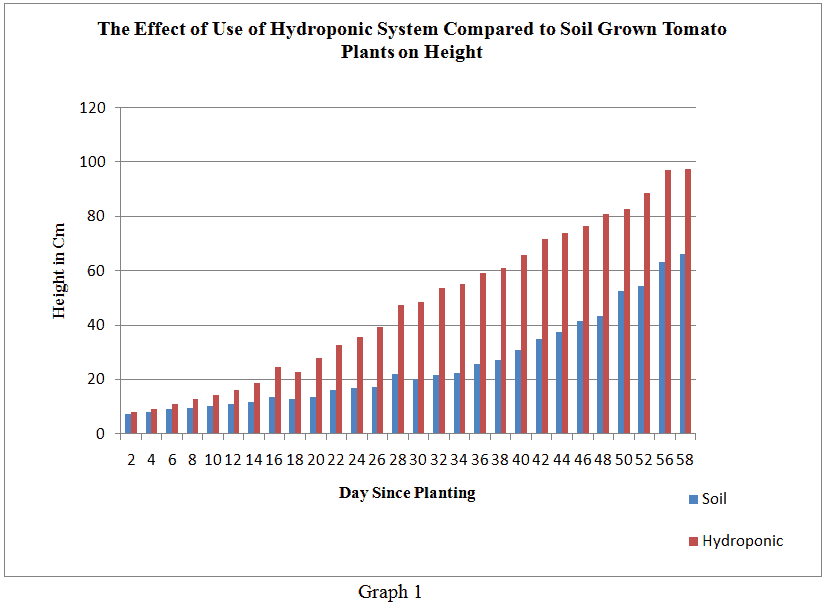
Source: includes more comparisons from studying Holland hybrid tomatoes.
The simple reasoning behind this improved growth is the lack of energy spent ‘hunting’ for nutrients and minerals within the environment. Instead the roots are consistently presented with a uniform nutrient solution.
Some other advantages include less water usage (more sustainable), a lower risk of disease and pests that can harm the plants, and my personal favourite- no weeding! Although I do enjoy digging in the dirt with my hori-hori knife…
There are some disadvantages to hydroponics
The overall disadvantage to growing plants hydroponically is the learning curve. Although it is not that hard to successfully grow plants in a hydroponic system, it is definitely more difficult than in soil. Like anything worth doing, it will take some time to gain experience and perfect your system. But that is half the fun! This is because you are essentially creating a mini (well not always mini) artificial environment. You control the water, the nutrients, the lighting, and pretty well everything else the plant needs for healthy growth.
The other downside can be cost. Creating a state-of-the-art hydroponic system can get pricey. However, with some ingenuity you can create your own system at a fair discount.
The 6 different types of hydroponic systems
Deep water culture
This is by far and away the simplest hydroponic system to construct. This system can be scaled up to grow commercially, or scaled down to a single container at home.
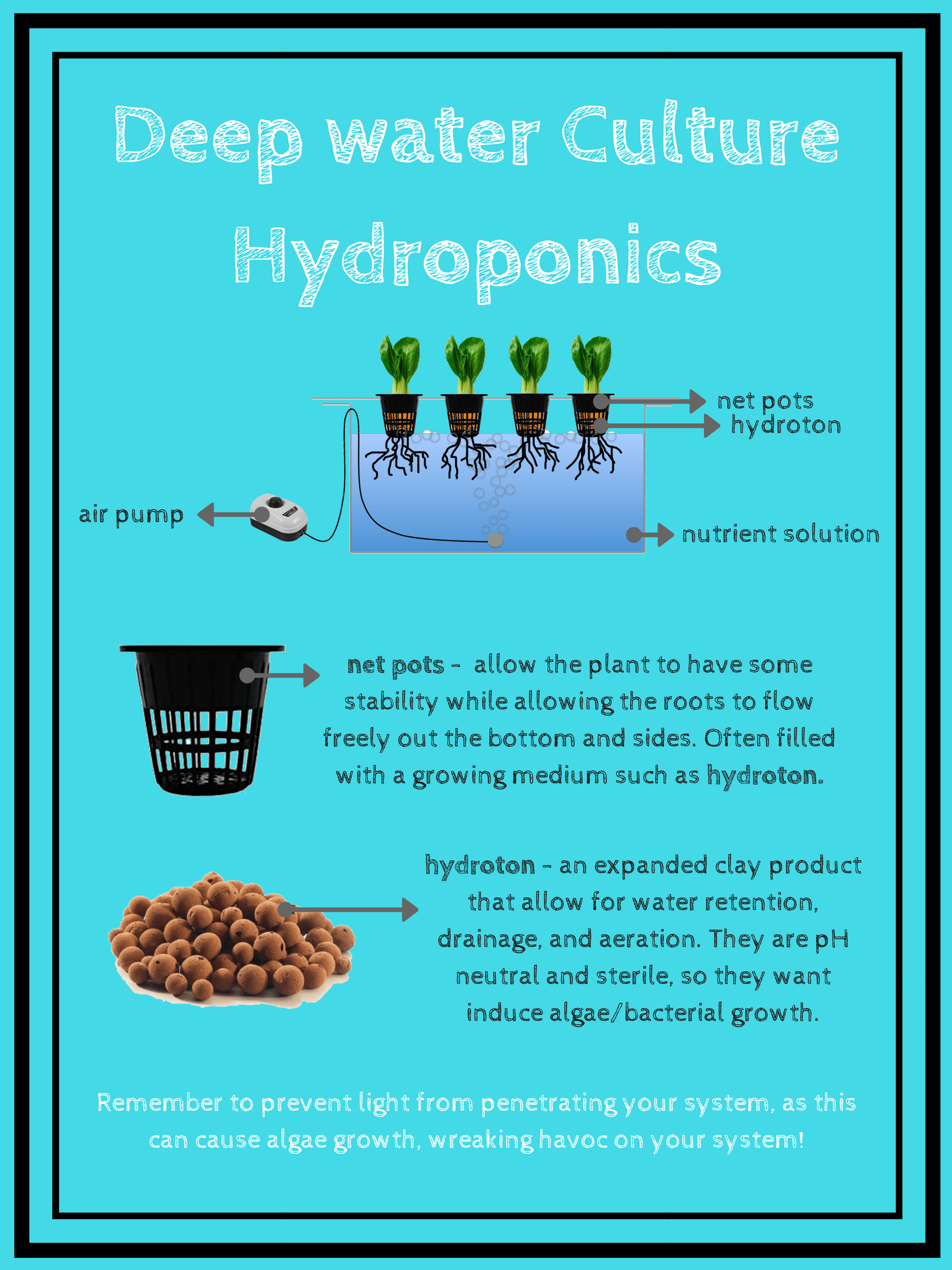
In a deep water culture system a reservoir holds the water, which contains a nutrient solution. The plants are suspended in a growing medium within net pots above the water. Their roots extend from the net pots into the nutrient solution below. The entire hydroponic system is aerated using an air pump and air stone at the bottom of the reservoir. This constantly provides fresh oxygen and makes the nutrients available for the plants. Aerating the water actually prevents the plant roots from downing in the nutrient solution. Sounds odd, but it is actually possible.
Benefits of a Deep water culture system
- Very inexpensive to set up and get started in hydroponics
- Little to no moving parts
- Extremely low maintenance
- Nearly 100% sustainable with little to no water waste
- Much higher yields in comparison to plants grown in soil
Downside of a Deep water culture system
- Can be challenging to grow plants with long growing periods
- Not the best choice for large plants
- pH swings in the reservoir can be large in small systems
Wick hydroponic system
This is another one of the extremely simple hydroponic systems. This is similar to deep water culture with the addition of a wick system. Here, a wick is used to transport water and nutrients from the reservoir to the plants. It is sometimes debated whether or not this system requires an air pump to oxygenate the nutrient solution. However, without it the plants are still susceptible to drowning. The air pump also helps keep the nutrients evenly mixed at all times, as the nutrients can settle to the bottom over time in still water.
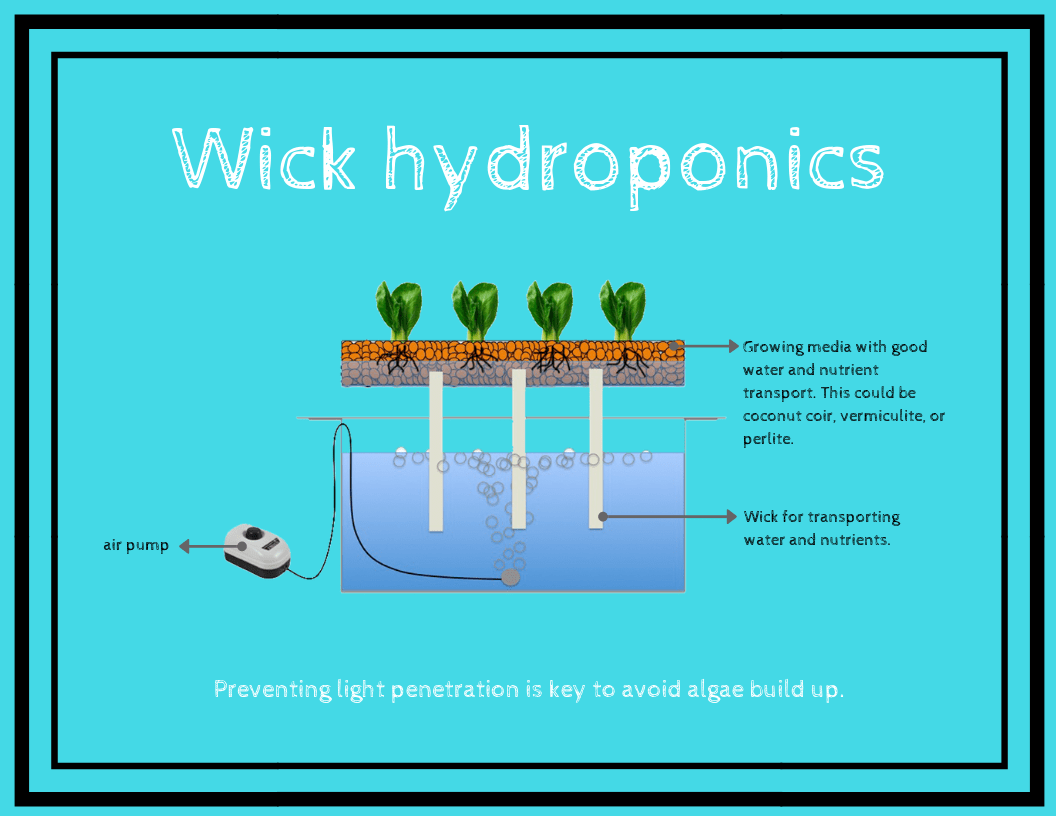
Benefits of wick system
- Very easy to construct and extremely low cost
- Can be used as a completely passive system without an air pump
- Virtually maintenance free
Downside of a wick system
- Poor system for both large and fruiting plants. These plants require a large volume of water uptake as they increase in size, and the wick is often unable to keep up.
- Less efficient at delivering nutrients (especially without an air pump)
- Plants often absorb nutrients unevenly. This can lead to a build up of mineral salts in the growing media.
Ebb and flow hydroponic system
Unlike the previous two hydroponic systems discussed, ebb and flow systems do not supply the plants with the nutrient solution on a constant basis.
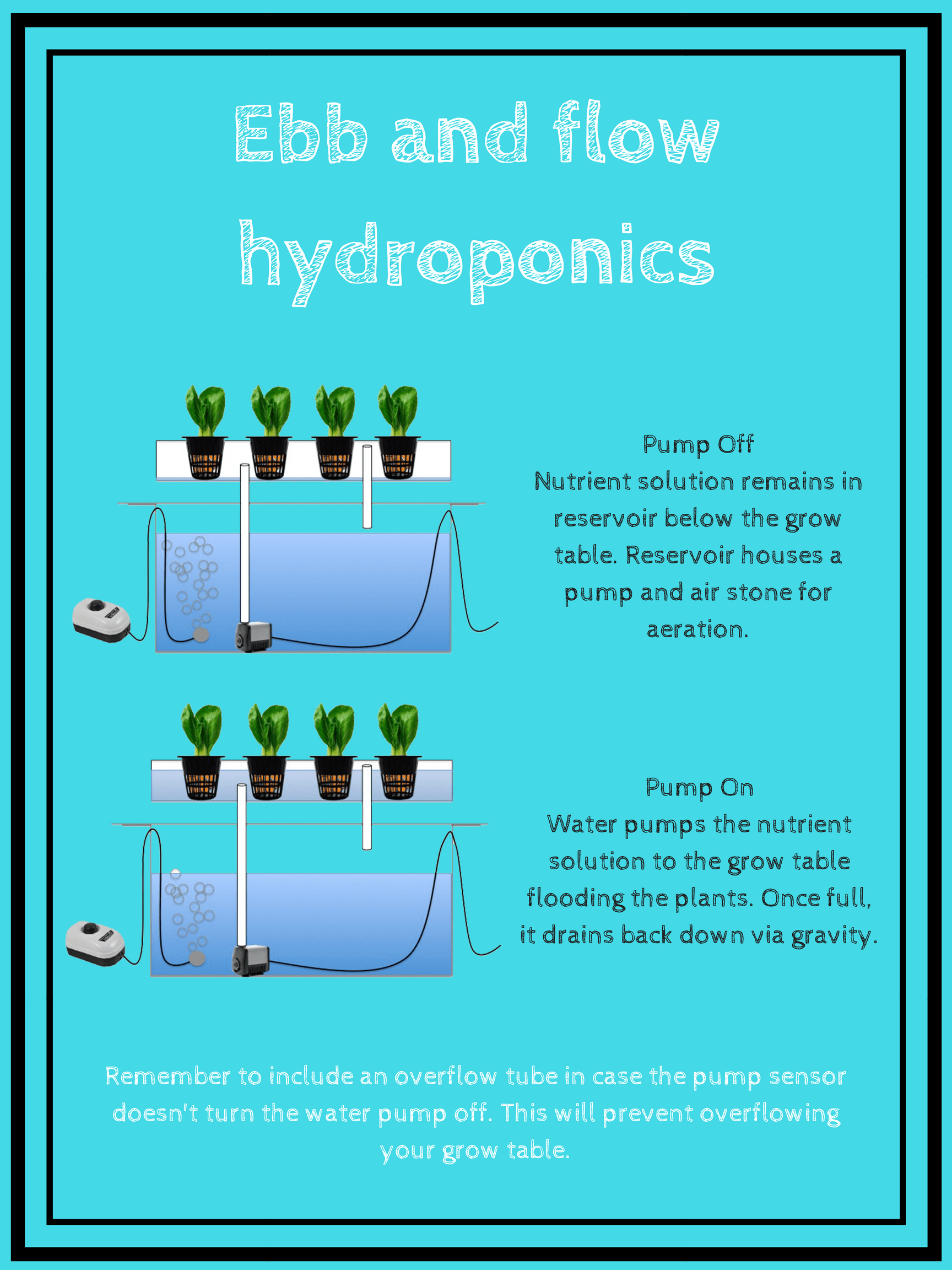
Similar to other hydroponic systems, ebb and flow contains a nutrient reservoir that sits below the grow table or grow tray. The nutrient solution is actively pumped from the reservoir flooding the grow table using a submersible pump/fountain pump. The nutrient solution floods the system until it reaches the desired height where it can soak the plant roots. This is typically just below where the preset overflow tube is set.
Once the grow table has flooded (height of overflow tube), it drains back down to the reservoir to be recirculated again. The overflow tube sets the water height for this system, as well as prevents overflowing the grow table. When the pump shuts off (triggered by a timer), the water siphons back down the pump tube via gravity, draining the grow table.
This entire process occurs at specifically timed intervals depending on:
- Plant size and growth cycle (elongation vs. fruiting)
- Water required for the plants
- Temperature and humidity
Once again, similar to the other hydroponic systems, the nutrient reservoir is continually aerated using an air pump and air stone.
Benefits of ebb and flow
- Efficient use of energy (not continuously pumping)
- Efficient use of water
- Incredibly flexible and customizable
Downside of ebb and flow
- Plants roots are susceptible to drying out
- Can require a large amount of growing medium (if not using net pots)
- Entire system can crash if pump fails
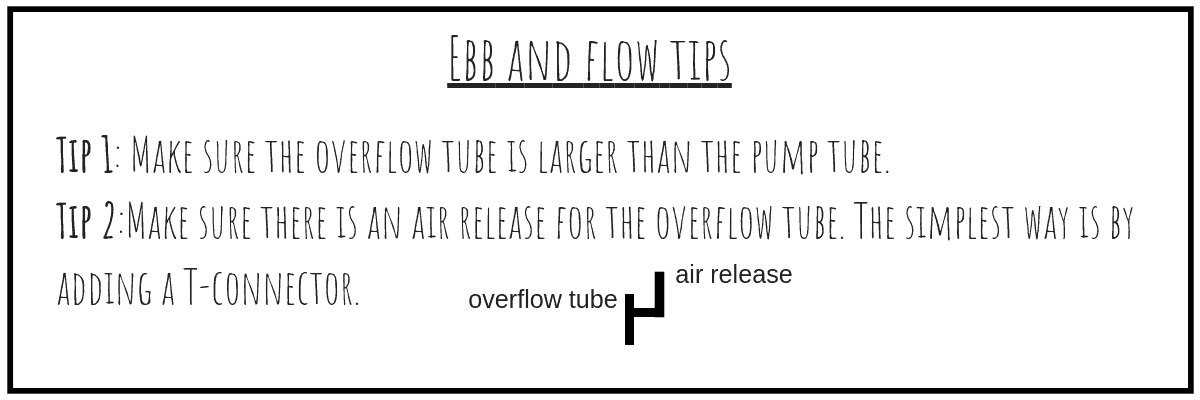
Drip hydroponic system
This is more commonly seen in commercial operations. They are simple to operate at a large scale, but can become expensive and overkill in small home hydroponic systems. The other reason drip systems are used commercially is because they work extremely well.
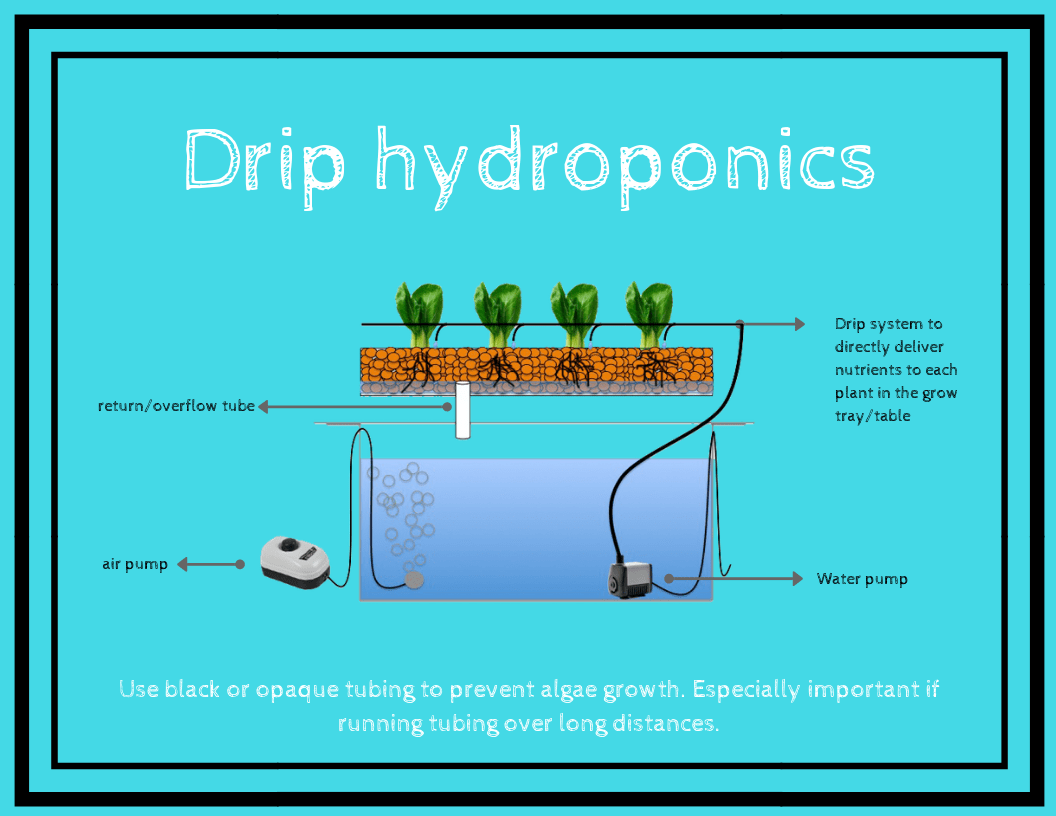
This hydroponic system is rather simple once understood. The nutrient solution is pumped from the reservoir through tubing to the top of the growing media and dripped directly beside the plant. The nutrient solution slowly drains down through the grow table soaking both the roots and the growing media. As the nutrient solution collects at the base of the grow table, it will hit the return or overflow tube and drain back to the reservoir via gravity.
There are actually two types of drip hydroponic systems. The first is a recirculating system (pictured above), where the nutrient solution is returned to the reservoir after passing through the growing media. This is also called a recovery system and is sustainable, as it results in very little water use (except for plant growth). The second is a non-recirculating system. This system is often used by commercial growers on a large scale. You may be thinking how that sounds incredibly wasteful. However, commercial operations understand their plants and the growing needs so they can water at extremely precise intervals. This allows for just enough water to saturate the growing media without waste.
Benefits of drip hydroponics
- Precise control over ‘feeding’
- A great system for larger plants with longer growing periods
- Little to no water waste (when done properly)
Downside of drip hydroponics
- It can be expensive for the drip parts depending on your location
- Generally overkill for smaller gardens
- If not controlled, it is extremely wasteful
- Recirculating method can lead to some pH fluctuations
Nutrient Film technique
This is the most common commercially used hydroponic system. This hydroponic system is best suited to small, quick growing plants such as lettuces and other greens.
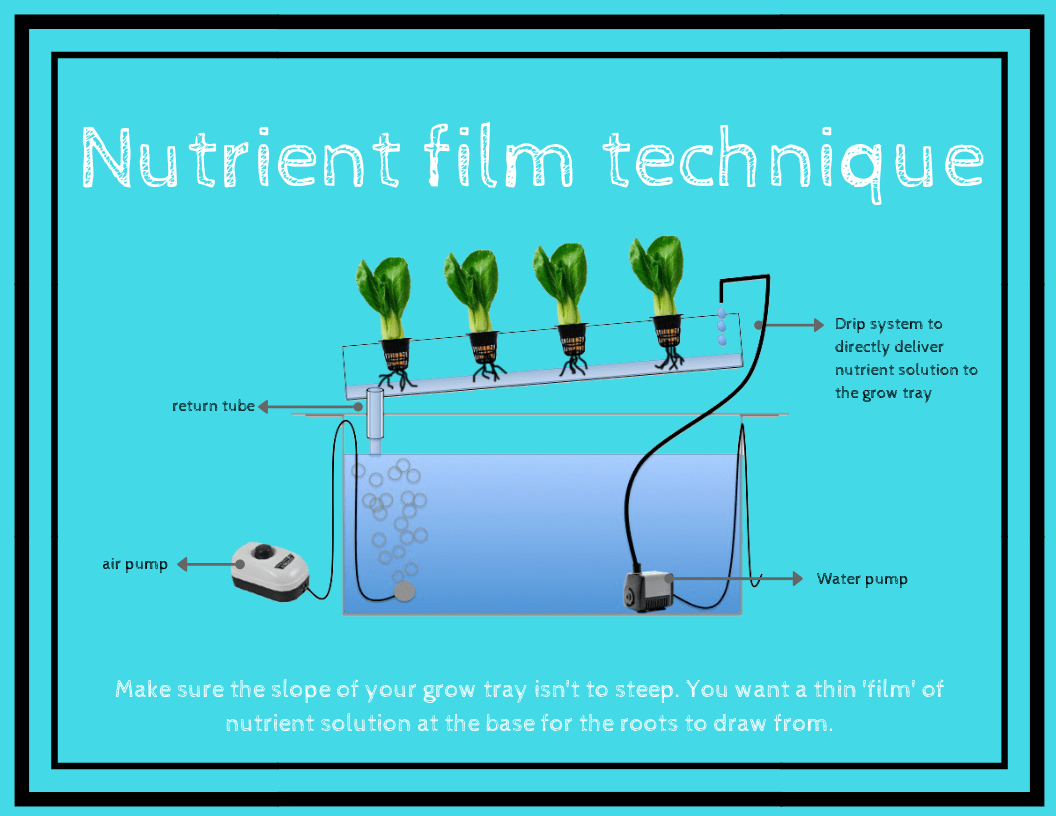
Once again, this is a fairly simple system (notice the trend…). Nutrient solution is pumped from a reservoir to a grow tray above. This time the tray is built at a slight angle so the nutrient solution follows gravity down the length of the tray. This creates the ‘film’ of nutrient solution at the base of the grow tray for the plant roots. As the film passes the roots, they are able to stay hydrated while pulling up the nutrients required for growth.
Just above the film, the plants in the grow tray are suspended above in growing media and net pots or baskets. However, unlike deep water culture, the plant roots are not completely submerged in nutrient solution.
The excess nutrient solution then flows through the return tube and back into the reservoir. Therefore, this is also considered a recirculating hydroponic system.
While commercial growers use specifically made grow trays/channels, hobby gardeners can get by using rain gutters or PVC piping. If you are looking to build an NFT setup for yourself, the slope should be between 1:30 to 1:40. That means that for every 30-40 inches of run, there should be a 1 inch drop in height. The recommended rate of water flow is between 1/4 to 1/2 gallon per minute.
Benefits of nutrient film technique hydroponics
- Minimal growing medium needed (even for large operations)
- Completely recirculating, and thus a sustainable form of growing
- Works great for smaller, quick growing plants
Downside of nutrient film technique hydroponics
- Any sort of pump failure will result in plant death
- Large root systems can cause nutrient backups or clogs
- Can be difficult to perfect slope and water rate for inexperienced growers
Aeroponics
The last of our hydroponic systems is aeroponics. This is without a doubt the most technically difficult system.
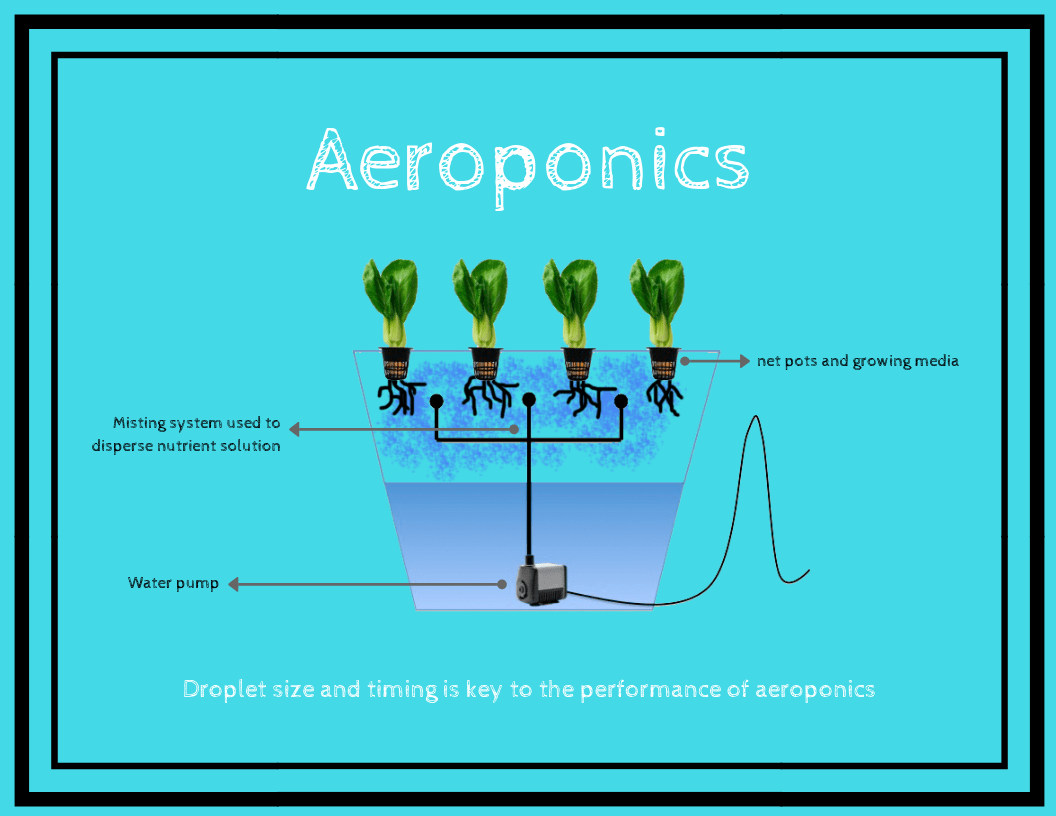
In an aeroponic system, the nutrient solution is pumped from the reservoir to misting heads above the water line. This creates a thin mist within the reservoir that is able to coat the plant roots hanging from above. The plants are grown similarly to deep water culture. They are planted in a growing media and contained within net pots on the surface or in the lid of the reservoir. The roots are then able to grow below hanging in mid air. The goal behind this type of setup is to allow the roots the maximum amount of oxygen possible. This in theory allows the plants to grow faster than any other setup.
Roots coated with a fine mist grow much faster and appear more bush like. This effectively creates a larger surface area to bind nutrient solution and take up oxygen for the plant.
The determining factor of success is droplet size and timing. If the droplets are too large, they will likely fall without interacting with the plant roots.
While some aeroponic systems mist constantly, others have had success misting on a specific schedule. The difficulty of this lies in the specialized misting nozzles required to build the system, as well as fine tuning the growth environment.
Benefits of aeroponics
- Greatest level of oxygenation for plant roots
- Potentially the best system for fast plant growth
- Little to no growing media
- Less water usage
Downside of aeroponics
- Typically the most expensive system to build
- Mist heads can clog from mineral build up (especially if you are using hard water)
- Plant roots are most susceptible to drying out as they hang in mid air
- Most difficult system to perfect growing
Final thoughts
Well there you have it, the six different types of hydroponic systems. Hopefully by this point you have a better understanding of what hydroponics is, and how it works. Each system has strengths and weaknesses, but any of them can result in a great garden with a little practice. No matter which you choose, your plants will grow fast with some proper care. Even if your first attempt gets a little off track, hydroponics offers extreme flexibility, which will help you correct any problems and get back on course.
If you are interested in watching a step-by-step build, stay tuned as we will be releasing a detailed outline of our latest hydroponic build. Currently, our seedlings are growing fast and nearly ready to be transferred into the net pots.
You might also enjoy:
The lowdown on hydroponic nutrients- what are they and how to spot problems

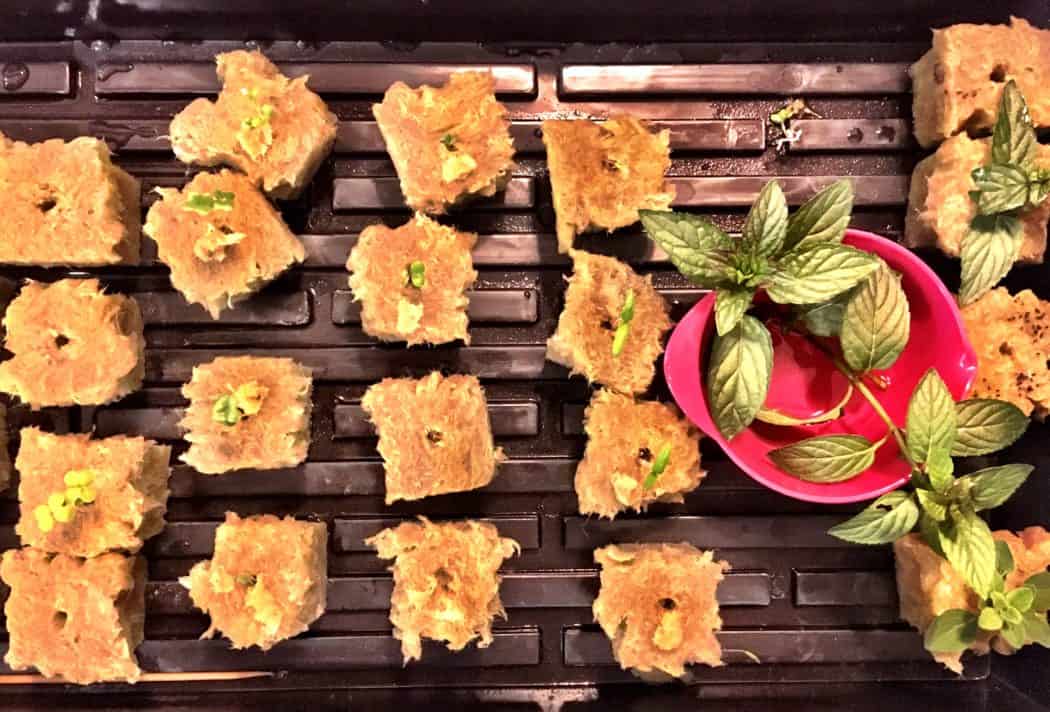
No Comments